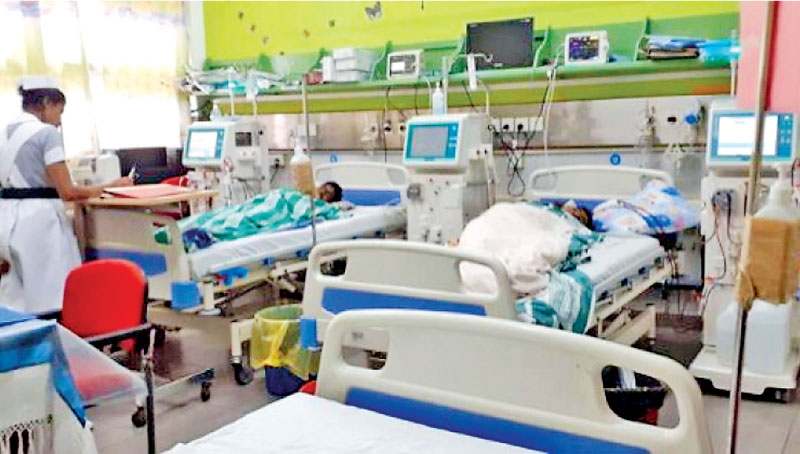Tuesday Dec 02, 2025
Tuesday Dec 02, 2025
Friday, 12 May 2023 02:27 - - {{hitsCtrl.values.hits}}

Compared to other services, medical equipment downtime can have life-threatening consequences when providing health services to patients
By Eng. Nihal Cooray
I am writing this not with academic or similar intent but to urge the relevant authorities to take immediate action on a vital issue affecting provision of satisfactory health services to the community. Although I had raised my voice as a responsible professional engineer and a concerned citizen in many forums, after reading the recent news items on the problems faced by Sri Lankan public health services due to shortages of medical and other personnel, medicines, equipment, etc., I thought it is time that we must bring our concern to the notice of relevant authorities.
Having worked in large Government corporations and private sector manufacturing companies I know the value of proper maintenance of machinery and equipment in order to keep the downtime to a minimum. Even with shortages of spares and other services, as young engineers we strived to maintain, repair, refurbish or modify machinery and equipment in order to ensure uninterrupted production. To achieve this a genuine and innovative mechanical and electrical technical workforce played a supportive role.
Compared to other services, medical equipment downtime can have life-threatening consequences when providing health services to patients. Medical equipment failures or breakdowns, can lead to delays in diagnosis and treatment, cancellation of vital surgeries, and emergency care resulting in severe hardship to patients and sometimes even fatalities. Due to improper or inadequate maintenance or upkeep of equipment, frequent breakdown will occur which may need repairs or replacement which will result in long waiting times and increased costs. This can further impact the patients and will also affect the financial viability of the institution.
A useful research study has been carried out by Dr. S.W.S.B. Dasanayaka of the University of Moratuwa related to performance of healthcare equipment in public medical institutions in Sri Lanka. Based on a case study of 12 major hospitals in the Colombo district and outside, he has discussed the extent of unusable equipment, causes and remedial measures which I think would be a useful eye opener for hospital administrators to improve and update present maintenance systems.
It must be mentioned that hospital equipment also includes non-medical equipment comprising supporting equipment and machinery such as generators, steam or water boilers, air compressors, oxygen and other gas generators, waste management plants, hazardous and non-hazardous waste water treatment plants, internal transport equipment including elevators, etc. Failure of any of these could cause interruptions in providing medical services. Therefore it is very essential to implement effective state-of-the-art maintenance or broadly speaking asset management with modern information and tracking systems.
The field of maintenance management has developed over the years to an extent that many leading organisations and companies are very close to zero downtime. These systems use advanced preventive and risk based predictive maintenance using the Industry 4.0 approach and also using innovative Artificial Intelligence (AI) systems. Sustainable public procurement policies among other policies take into account reliability, safety and maintainability of machinery and equipment procurement. It is sad to note that many present day mechanical and electrical engineers in Sri Lanka do not prefer to study and get trained in maintenance engineering and management unlike in the past. With effective promotional and awareness campaigning as well as giving due recognition to this field this situation can be reversed. I feel that national hospitals are well-equipped to provide training in maintenance and repair to interns and postgraduate trainees.
During the COVID-19 pandemic, medical institutions all over the world experienced problems with crucial equipment such as ventilators, dialysis machines, personal protective equipment, and sanitising equipment. This resulted in higher demand for repair and maintenance. Despite the longstanding issue of refusal by manufacturers to provide information to repair medical equipment, hospitals were forced to attempt repairing to save lives. It must be mentioned that the EU ‘Right to repair act’ and US ‘Critical Medical Infrastructure Right-to-Repair Act of 2020’ has encouraged and facilitated the repair and refurbishing of vital medical equipment which will contribute to reducing downtime. The ‘Right-to-Repair’ Act provides mandatory provisions requiring manufacturers to share information with consumers on repair and maintenance of the product or equipment .Sri Lanka should seriously consider such legislation at a time when the country cannot afford new equipment and also promote repairing/refurbishing which will make the medical services more affordable, efficient, and sustainable.
Considering the importance of patient care, the country must adopt the best maintenance systems backed by well-trained engineering and technical staff at any cost. We could also consider public private participation in investing in maintenance systems and have no doubt many companies will take it as a moral obligation. Our financial institutions and insurance companies will most certainly come out with innovative packages. It is very important that the policymakers and engineering fraternity realise the life saving and resource saving potential of implementing state-of-the-art maintenance systems in the health sector as well as in other essential services such as power, water and transport.